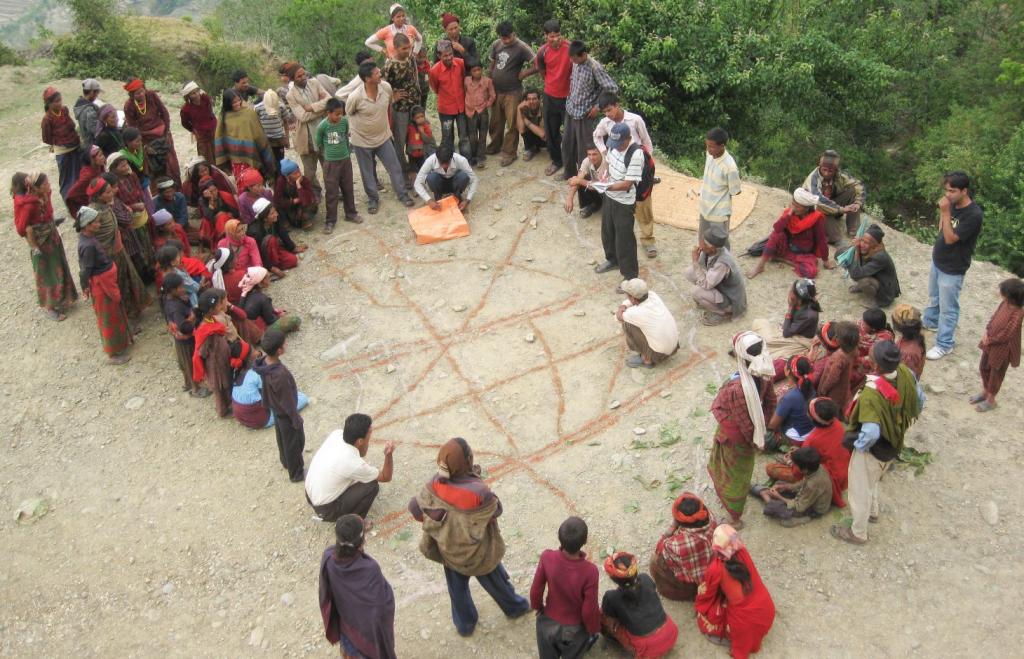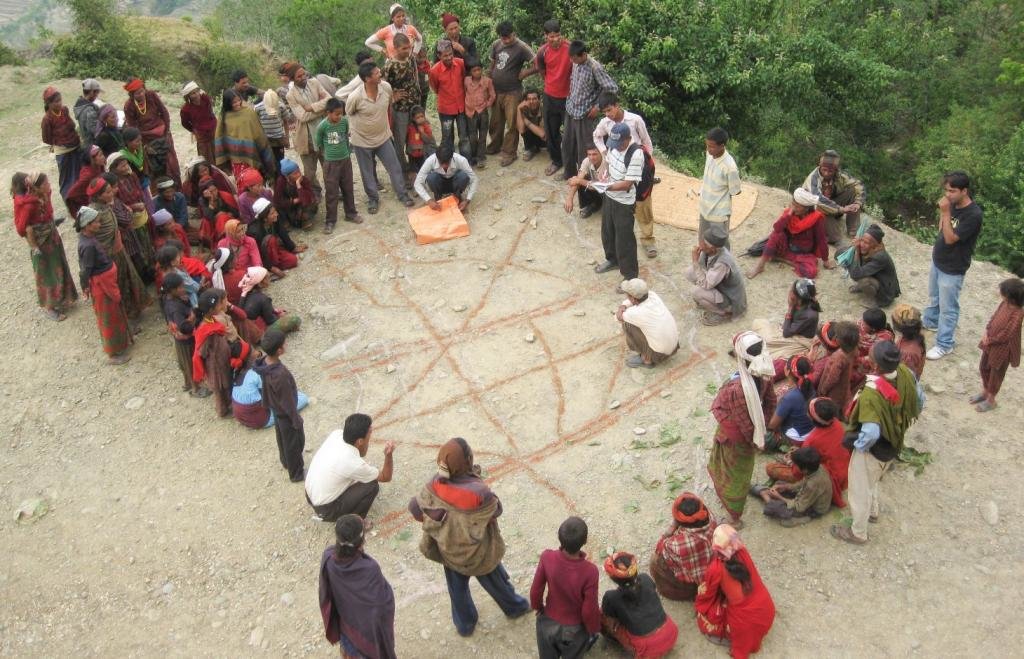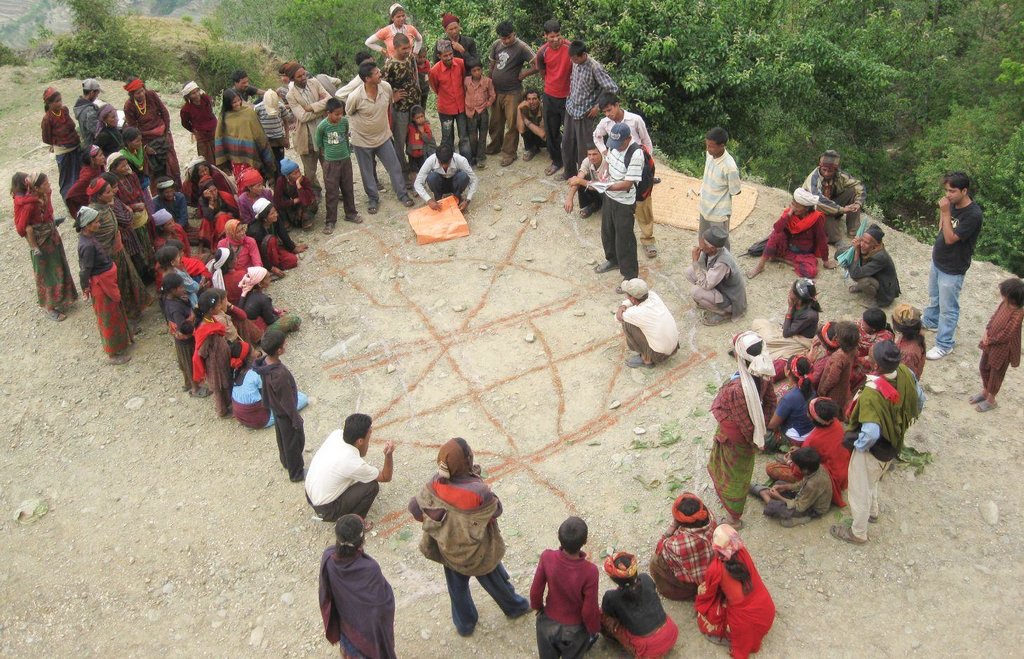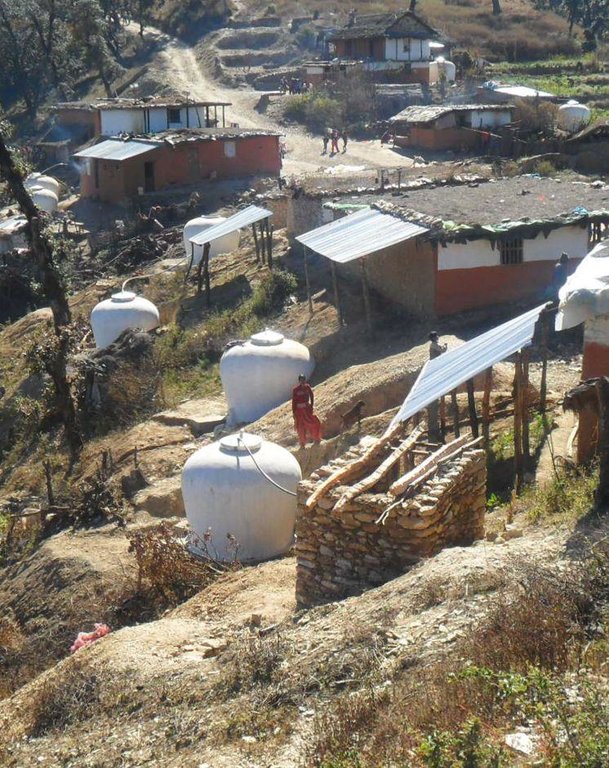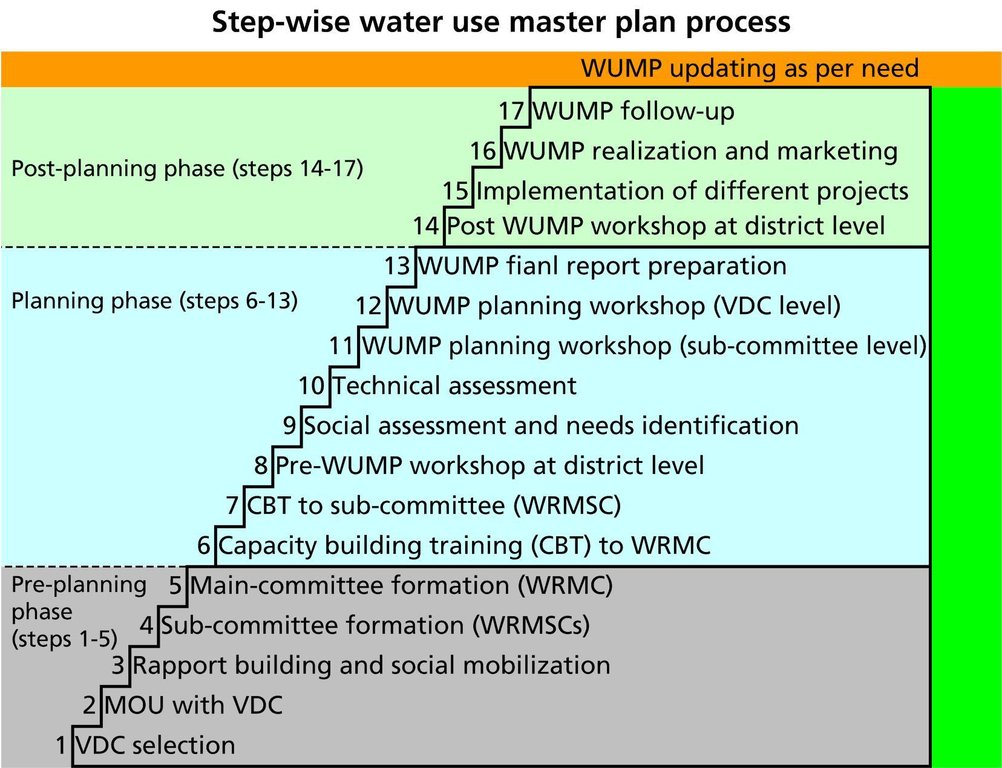Water use master plan [ເນໂປ]
- ການສ້າງ:
- ປັບປູງ:
- ຜູ້ສັງລວມຂໍ້ມູນ: Shreedip Sigdel
- ບັນນາທິການ: –
- ຜູ້ທົບທວນຄືນ: Fabian Ottiger
Jal upoyog guru yogana (Main Contributor: HELVETAS Nepal)
approaches_2535 - ເນໂປ
ເບິ່ງພາກສ່ວນ
ຂະຫຍາຍທັງໝົດ ຍຸບທັງໝົດ1. ຂໍ້ມູນທົ່ວໄປ
1.2 ລາຍລະອຽດ ການຕິດຕໍ່ ຂອງບຸກຄົນທີ່ຊັບພະຍາກອນ ແລະ ສະຖາບັນ ການມີສ່ວນຮ່ວມ ໃນການປະເມີນຜົນ ແລະ ເອກະສານ ຂອງວິທີທາງ
ຜູ້ຊ່ຽວຊານ ດ້ານການຄຸ້ມຄອງ ທີ່ດິນແບບຍືນຍົງ:
Jürg Merz
+977 1 5524925; 9851044421 (M)
juerg.merz@helvetas.org.np
HELVETAS Swiss Intercooperation Nepal
ສະວິດເຊີແລນ
ຊື່ຂອງ ສະຖາບັນການຈັດຕັ້ງ ທີ່ອໍານວຍຄວາມສະດວກ ໃນການສ້າງເອກກະສານ ຫຼື ປະເມີນແນວທາງ (ຖ້າກ່ຽວຂ້ອງ)
HELVETAS (Swiss Intercooperation)ຊື່ຂອງ ສະຖາບັນການຈັດຕັ້ງ ທີ່ອໍານວຍຄວາມສະດວກ ໃນການສ້າງເອກກະສານ ຫຼື ປະເມີນແນວທາງ (ຖ້າກ່ຽວຂ້ອງ)
ICIMOD International Centre for Integrated Mountain Development (ICIMOD) - ເນໂປ1.3 ເງື່ອນໄຂ ຂອງການນໍາໃຊ້ເອກກະສານຂໍ້ມູນ ຂອງ WOCAT
ເມື່ອໃດທີ່ໄດ້ສັງລວມຂໍ້ມູນ (ຢູ່ພາກສະໜາມ)?
01/03/2013
ຜູ້ສັງລວມ ແລະ ບັນດາຜູ້ຕອບແບບສອບຖາມ ຍອມຮັບໃນເງື່ອນໄຂ ການນໍາໃຊ້ຂໍ້ມູນເອກະສານ ທີ່ສ້າງຂື້ນ ໂດຍຜ່ານ ອົງການ WOCAT:
ແມ່ນ
2. ພັນລະນາ ແນວທາງການຄຸ້ມຄອງນໍາໃຊ້ດິນແບບຍືນຍົງ
2.1 ການອະທິບາຍ ໂດຍຫຍໍ້ ຂອງວິທີທາງ
A water use master plan supports the development of integrated water resources at the local level; all stakeholders, including disadvantaged groups, take part in the plan.
2.2 ການອະທິບາຍ ລາຍລະອຽດ ຂອງວິທີທາງ
ການອະທິບາຍ ລາຍລະອຽດ ຂອງວິທີທາງ:
Aims / objectives: A water use master plan (WUMP) is a holistic, participatory, and inclusive planning process that takes an integrated approach to the management of water resources and uses at the village level. The WUMP specifies the total water budget for its planning unit, the village development committee (VDC), and explores potential uses for it. It empowers marginalized groups to claim their rights to an equitable share of water within and between communities. The WUMP also helps local bodies with annual and periodic planning and project prioritization.
Methods: The WUMP is a 17-step process that includes social mobilization, the formation of inclusive management committees, capacity building for everyone involved in the process, and, as a final step, social assessment using various participatory rural appraisal (PRA) tools. Simultaneously, the technical part of the process evaluates the capacity of all water resources and their potential uses. In a workshop facilitated by NGO staff, the community discusses suggestions formulated by the two participatory assessments, prioritizes possible projects, and formulates plans. The VDC representatives decide which plans can be implemented using their own resources and which need external support. The WUMP then organizes a workshop to present these plans to various organizations in order to get their commitment and support. The prioritized projects are implemented according to the WUMP.
The plan also contains a series of long-term activities and during the course of its implementation, there is sufficient latitude to allow the community to rectify its original plans in order to put into practise lessons learned during earlier phases and to continue to review and modify the plan as needed.
2.3 ຮູບພາບຂອງແນວທາງ
2.5 ປະເທດ / ເຂດ / ສະຖານທີ່ບ່ອນທີ່ແນວທາງໄດ້ຖືກນໍາໃຊ້
ປະເທດ:
ເນໂປ
ຂໍ້ມູນເພີ່ມເຕີມຂອງສະຖານທີ່:
15 districts in the Western, Mid-Western, and Far-Western Development Regions of Nepal
2.7 ປະເພດຂອງແນວທາງ
- ພາຍໃຕ້ໂຄງການ / ແຜນງານ
2.8 ເປົ້າໝາຍ / ຈຸດປະສົງຫຼັກ ຂອງການຈັດຕັ້ງປະຕິບັດ ວິທີທາງ
The Approach focused mainly on SLM with other activities (Water conservation, water sources and catchment area)
• Establish inclusive water planning and water resource management at the community level
• Ensure the optimal use of water resources; see that water is equitably and efficiently distributed
• Promote conservation of water and natural resources linked to water; implement water projects based on the plan agreed by the entire community
The SLM Approach addressed the following problems: • Issues on access to water are often contentious, communities often quarrel over water rights
• A lack of coordinated planning at the local level
• A growing demand for water both for domestic and agricultural use
• Water sources are diminishing and the changing climate will further aggravate this
2.9 ເງື່ອນໄຂອໍານວຍ ຫຼື ຂັດຂວາງການປະຕິບັດຂອງເຕັກໂນໂລຢີ / ເຕັກໂນໂລຢີການນໍາໃຊ້ຕາມແນວທາງ
ສັງຄົມ / ວັດທະນະທໍາ / ມາດຕະຖານ ແລະ ຄຸນຄ່າທາງສາສະໜາ
- ເຊື່ອງຊ້ອນ
Communities are reluctant to share water resources and
hide the sources of water during planning
Treatment through the SLM Approach: Earn everyone's trust through meetings, dialogue, and social mapping that includes all stakeholders including disadvantaged groups.
ມີຄວາມສາມາດ / ເຂັ້າເຖິງຊັບພະຍາກອນດ້ານການເງິນ ແລະ ການບໍລິການ
- ເຊື່ອງຊ້ອນ
When the WUMP is implemented by the VDC using its
own funds it usually takes a long time.
Treatment through the SLM Approach: Collaborate and network with resource organizations such as INGOs and donor funded programmes for funding.
ການກໍ່ຕັ້ງສະຖາບັນ
- ເຊື່ອງຊ້ອນ
There is no elected body in the VDC and no one takes permanent ownership of the WUMP.
Treatment through the SLM Approach: Create an advisory body consisting of representatives from all political parties.
ກ່ຽວກັບກົດໝາຍ (ສິດນໍາໃຊ້ດິນ, ສິດນໍາໃຊ້ນໍ້າ)
- ອໍານວຍ
Ensuring equitable use of water resources is a key feature of the WUMP approach.
ຄວາມຮູ້ກ່ຽວກັບການຄຸ້ມຄອງ ທີ່ດິນແບບຍືນຍົງ, ການເຂົ້າເຖິງການສະໜັບສະໜູນ ທາງດ້ານວິຊາການ
- ເຊື່ອງຊ້ອນ
When the administrative boundaries of a VDC do not coincide with its physical watershed boundaries, it can be difficult to make technical decisions.
Treatment through the SLM Approach: Cluster VDCs into groups in the same sub/watershed.
ອື່ນໆ
- ເຊື່ອງຊ້ອນ
Low awareness of the need for conservation and of the
need to use water efficiently
Treatment through the SLM Approach: Intensive awareness raising and capacity building programmes
3. ການມີສ່ວນຮ່ວມ ແລະ ບົດບາດຂອງພາກສ່ວນທີ່ກ່ຽວຂ້ອງທີ່ໄດ້ມີສ່ວນຮ່ວມ
3.1 ຜູ້ມີສ່ວນຮ່ວມ ໃນວິທີທາງ ແລະ ພາລະບົດບາດ ຂອງເຂົາເຈົ້າ
- ຜູ້ນໍາໃຊ້ດິນໃນທ້ອງຖິ່ນ / ຊຸມຊົນທ້ອງຖິ່ນ
VDC
Equal participation of men and women is encouraged during the social assessment and needs identification phase. During the planning and implementation phases, the participation of women in decision making is ensured through a provision that there be a representation of at least 33% women in the water resource management committees, sub-committees, and users' committees. Disadvantaged groups (Dalit and Janajati among others) are requested to participate in numbers proportional to the percentage they represent in the community in all activities and committees.
- ຄູອາຈານ / ນັກຮຽນ / ນັກສຶກສາ
- ອົງການຈັດຕັ້ງ ທີ່ບໍ່ຂື້ນກັບລັດຖະບານ
HELVETAS
- ພະນັກງານຂັ້ນສູນກາງ (ຜູ້ວາງແຜນ, ຜູ້ສ້າງນະໂຍບາຍ)
3.2 ການມີສ່ວນຮ່ວມຂອງຜູ້ນໍາໃຊ້ທີ່ດິນໃນທ້ອງຖິ່ນ / ຊຸມຊົນທ້ອງຖິ່ນໃນໄລຍະທີ່ແຕກຕ່າງກັນຂອງແນວທາງ
| ການລວບລວມ ເອົາຜູ້ນໍາໃຊ້ດິນ ໃນທ້ອງຖິ່ນ / ຊຸມຊົນທ້ອງຖິ່ນ | ໃຫ້ລະບຸ ຜູ້ໃດທີ່ມີສ່ວນຮ່ວມ ໃນແຕ່ລະກິດຈະກໍາ? | |
|---|---|---|
| ການເລີ່ມຕົ້ນ / ແຮງຈູງໃຈ | ການຮ່ວມມື | Community meetings, decision taken by the VDC on how to prepare the WUMP |
| ການວາງແຜນ | ການຮ່ວມມື | Social and resource mapping, social assessments, technical assessments and planning |
| ການປະຕິບັດ | ການນໍາໃໍຊ້ເອງ | Implementation of the water projects, source protection/conservation |
| ຕິດຕາມກວດກາ / ການປະເມີນຜົນ | ການຮ່ວມມື | Review of the plan, community monitoring during the construction phase, follow-up monitoring during routine operation |
| Research | ບໍ່ມີ |
3.3 ແຜນວາດ (ຖ້າມີ)
ການອະທິບາຍ:
The step-wise WUMP process
VDC = Village development committee
MOU = Memorandum of understanding
WRMC = Water resource management committee
WRMSC = Water resource management sub-committee
WUMP = Water use master plan
(AK Thaku)
3.4 ການຕັດສິນໃຈກ່ຽວກັບການຄັດເລືອກເຕັກໂນໂລຢີຂອງການຄຸ້ມຄອງທີ່ດິນແບບຍືນຍົງ / ເຕັກໂນໂລຢີ
ລະບຸ ຄົນທີ່ຕັດສິນໃຈ ກ່ຽວກັບການຄັດເລືອກຂອງ ເຕັກໂນໂລຢີ / ເຕັກໂນໂລຢີ ຈະໄດ້ຮັບການປະຕິບັດ:
- ຜູ້ນໍາໃຊ້ທີ່ດິນຫຼັກ, ການສະໜັບສະໜູນ ໂດຍຜູ້ຊ່ຽວຊານ ການນໍາໃຊ້ທີ່ດິນແບບຍືນຍົງ
ອະທິບາຍ:
Technologies are selected on the basis of suitability and availability of water sources by local communities with the support of technicians and the VDC.
Decisions on the method of implementing the SLM Technology were made by mainly by land users supported by SLM specialists. Since the VDC endorses the WUMP, it decides on implementation.
4. ການສະໜັບສະໜູນທາງດ້ານວິຊາການ, ການສ້າງຄວາມສາມາດ, ແລະ ການຈັດການຄວາມຮູ້.
4.1 ການສ້າງຄວາມສາມາດ / ການຝຶກອົບຮົມ
ຜູ້ນໍາໃຊ້ທີ່ດິນ ຫຼື ພາກສ່ວນກ່ຽວຂ້ອງອື່ນໆ ໄດ້ຮັບການຝຶກອົບຮົມບໍ່?
ແມ່ນ
- Local Community
ໃນຫົວຂໍ້:
• Social mobilization and awareness raising orientations, training
• Capacity building and training to WRMC and local service providers
4.3 ສະຖາບັນການສ້າງຄວາມເຂັ້ມແຂງ (ການພັດທະນາອົງການຈັດຕັ້ງ)
ສະຖາບັນ ໄດ້ຮັບການສ້າງຕັ້ງຂື້ນ ຫຼື ໄດ້ຮັບການສ້າງຄວາມເຂັ້ມແຂງ ໂດຍການຈັດຕັ້ງປະຕິບັດ ວິທີທາງບໍ່?
- ມີ, ຫຼາຍ
ລະບຸ ທາງສະຖາບັນ ໄດ້ສ້າງຄວາມເຂັ້ມແຂງ ໃນລະດັບໃດ (ຫຼາຍ):
- ທ້ອງຖິ່ນ
ລະບຸ ປະເພດ ຂອງສະໜັບສະໜູນ:
- ການສ້າງຄວາມອາດສາມາດ / ການຝຶກອົບຮົມ
- ອຸປະກອນ
ໃຫ້ລາຍລະອຽດເພີ່ມເຕີມ:
Support is provided to the VDC for the preparation of the WUMP
4.4 ຕິດຕາມກວດກາ ແລະ ປະເມີນຜົນ
ການຈັດຕັ້ງປະຕິບັດ ວິທີທາງ ໄດ້ມີການປະເມີນຜົນ ແລະ ຕິດຕາມບໍ?
ແມ່ນ
ຄວາມຄິດເຫັນ:
bio-physical aspects were monitored through measurements; indicators: Follow-up monitoring to check if the water sources are protected, and if the area is conserved by planting
technical aspects were monitored through measurements; indicators: Follow-up monitoring to check water sources and number of water projects implemented
socio-cultural aspects were monitored through measurements; indicators: Public hearings and audits to ensure transparency and community participation (especially of disadvantaged groups)
area treated aspects were monitored through measurements; indicators: Follow-up monitoring of implementation (as shown in the diagram )
no. of land users involved aspects were monitored through measurements; indicators: Public review, final commissioning: community contribution and participation (as shown in the diagram)
management of Approach aspects were monitored through measurements; indicators: WUMP follow-up: implementation of WUMP (as shown in the diagram )
Implementation of WUMP aspects were monitored through measurements; indicators: WUMP follow-up: implementation of WUMP (as shown in the diagram )
There were few changes in the Approach as a result of monitoring and evaluation: • All members of the community, even those with water resources on their own land, are willing to share water resources after participating in the WUMP.
• Disadvantaged groups participate on an equal footing in management committees and have equal access to water resources.
• The community realizes the need to protect water resources and begins to conserve water.
5. ການສະໜັບສະໜູນທາງດ້ານການເງິນ ແລະ ອຸປະກອນຈາກພາຍນອກ
5.1 ງົບປະມານປະຈໍາປີ ສໍາລັບວິທີທາງ ຂອງການຄຸ້ມຄອງ ທີ່ດິນແບບຍືນຍົງ
ຖ້າຫາກບໍ່ຮູ້ຈັດງົບປະມານທີ່ແນ່ນອນ ແມ່ນໃຫ້ປະມານເອົາ:
- 2,000-10,000
ຄໍາເຫັນ (ຕົວຢ່າງ: ແຫຼ່ງຂໍ້ມູນຫຼັກ ຂອງການສະໜອງທຶນ / ຜູ້ໃຫ້ທຶນທີ່ສໍາຄັນ):
Approach costs were met by the following donors: national non-government: 75.0%; local community / land user(s): 25.0%
5.2 ການສະໜັບສະໜູນ ທາງດ້ານການເງິນ / ອຸປະກອນ ສະໜອງໃຫ້ແກ່ຜູ້ນໍາທີ່ດິນ
ຜູ້ນໍາໃຊ້ດິນ ໄດ້ຮັບການສະໜັບສະໜູນ ທາງດ້ານ ການເງິນ / ອຸປະກອນ ໃນການຈັດຕັ້ງປະຕິບັດ ເຕັກໂນໂລຢີບໍ?
ບໍ່ແມ່ນ
5.3 ເງິນສົມທົບສໍາລັບການນໍາໃຊ້ສະເພາະປັດໃຈຂາເຂົ້າໃນການຜະລີດກະສິກໍາ (ລວມທັງແຮງງານ)
- ບໍ່ມີ
ຖ້າແຮງງານ ຂອງຜູ້ນໍາໃຊ້ດິນ ໄດ້ຮັບການສະໜັບສະໜູນ ປັດໃຈຂາເຂົ້າ, ແມ່ນບໍ່:
- ການອາສາ
5.4 ສິນເຊື່ອ
ໄດ້ປ່ອຍສິນເຊື່ອ ສະໜອງໃຫ້ພາຍໃຕ້ ວິທີການສໍາລັບກິດຈະກໍາ ການຄຸ້ມຄອງ ທີ່ດິນແບບຍືນນຍົງບໍ່?
ບໍ່ແມ່ນ
6. ວິເຄາະຜົນກະທົບ ແລະ ສັງລວມບັນຫາ
6.1 ຜົນກະທົບຂອງແນວທາງ
ການຈັດຕັ້ງປະຕິບັດ ວິທີທາງ ສາມາດຊ່ວຍຜູ້ນໍາໃຊ້ທີ່ດິນ ໃນການຈັດຕັ້ງປະຕິບັດ ແລະ ບໍາລຸງຮັກສາ ເຕັກໂນໂລຢີ ການຄຸ້ມຄອງ ທີ່ດິນແບບຍືນຍົງໄດ້ບໍ?
- ບໍ່
- ມີ, ໜ້ອຍໜຶ່ງ
- ມີ, ພໍສົມຄວນ
- ມີ, ຫຼາຍ
Water, forests, and land are all interlinked. Proper management of water resources, source protection, and conservation are all part of sustainable land management.
ການຈັດຕັ້ງປະຕິບັດ ວິທີທາງ ສາມາດສ້າງຄວາມເຂັ້ມແຂງ ທາງສັງຄົມ ແລະ ເສດຖະກິດບໍ່?
- ບໍ່
- ມີ, ໜ້ອຍໜຶ່ງ
- ມີ, ພໍສົມຄວນ
- ມີ, ຫຼາຍ
Disadvantaged groups participate and share benefits on equal terms.
Did other land users / projects adopt the Approach?
- ບໍ່
- ມີ, ໜ້ອຍໜຶ່ງ
- ມີ, ພໍສົມຄວນ
- ມີ, ຫຼາຍ
This approach has been replicated by the Rural Water Resources Management Project of FINNIDA, the LIVE/EU project, and Nepal Water for Health (NEWAH), a national-level NGO in Nepal. Nepal's Ministry of Local Development, Department of Local Infrastructure and Roads, has expressed an interest in developing WUMPs for all the VDCs in Nepal.
Did the Approach lead to improved livelihoods / human well-being?
- ບໍ່
- ມີ, ໜ້ອຍໜຶ່ງ
- ມີ, ພໍສົມຄວນ
- ມີ, ຫຼາຍ
Having access to sustainable water resources improves livelihoods.
Did the Approach help to alleviate poverty?
- ບໍ່
- ມີ, ໜ້ອຍໜຶ່ງ
- ມີ, ພໍສົມຄວນ
- ມີ, ຫຼາຍ
Access to water improves hygiene and contributes to better health and to poverty alleviation.
6.2 ແຮງຈູງໃຈຫຼັກຂອງຜູ້ນໍາໃຊ້ທີ່ດິນໃນການປະຕິບັດການຄຸ້ມຄອງທີ່ດິນແບບຍືນຍົງ
6.3 ຄວາມຍືນຍົງຂອງກິດຈະກໍາວິທີທາງ
ຜູ້ນໍາໃຊ້ ທີ່ດິນ ສາມາດສືບຕໍ່ ການຈັດຕັ້ງປະຕິບັດ ຜ່ານວິທີທາງໄດ້ບໍ່ (ໂດຍປາດສະຈາກ ການຊ່ວຍເຫຼືອ ຈາກພາກສ່ວນພາຍນອກ)?
- ບໍ່ແນ່ນອນ
ຖ້າ ບໍ່ ຫຼື ບໍ່ແນ່ໃຈ, ໃຫ້ອະທິບາຍ ແລະ ຄໍາເຫັນ:
In order to ensure sustainability the following issues need to be addressed:
• Social: Coordinated planning in consultation with the local people; capacity building at all levels so that management committees, local service providers, local government, and the community as a whole can participate better, voice their concerns, and be part of the solution.
• Economic: The VDCs take a lead role, the beneficiaries need to be willing to share the costs and need to want to participate in activities such as quality control, and routine operation and maintenance schemes.
• Environment: Conservation of water sources, integrated water resources planning, and the efficient use of water
6.4 ຈຸດແຂງ / ຂໍ້ດີ ຂອງວິທີທາງ
| ຈຸດແຂງ / ຈຸດດີ / ໂອກາດ ຈາກທັດສະນະຂອງຜູ້ປ້ອນຂໍ້ມູນ ຫຼື ບຸກຄົນສຳຄັນ |
|---|
| Communities appreciate the WUMP approach (How to sustain/ enhance this strength: The Ministry of Local Development has expressed an interest in preparing national guidelines for this process in order to scale it up to all the VDCs in Nepal) |
| VDCs own the process both by participating and by contributing to the funding. (How to sustain/ enhance this strength: Need to simplify the process and make it more cost effective so that it is easier to replicate.) |
| An integrated approach to the use of water resources may help in climate change adaptation. (How to sustain/ enhance this strength: Strengthen awareness activities and continue to promote water conservation) |
|
The WUMP process is inclusive and is managed by the whole community. (How to sustain/ enhance this strength: Continue to strengthen the capacity of disadvantaged groups so that they can participate more actively.) |
6.5 ຈຸດອ່ອນ / ຂໍ້ເສຍຂອງແນວທາງ ແລະ ວິທີການແກ້ໄຂໃຫ້ເຂົາເຈົ້າ
| ຈຸດອ່ອນ ຫຼື ຂໍ້ເສຍ ຫຼື ຄວາມສ່ຽງ ໃນມຸມມອງຂອງ ຜູ້ສັງລວມຂໍ້ມູນ ຫຼື ບັນດາຜູ້ຕອບແບບສອບຖາມ | ມີວິທີການແກ້ໄຂຄືແນວໃດ? |
|---|---|
| Not all VDCs actively participate in the WUMP | When VDCs contribute funds for the WUMP, they are usually more actively involved. |
| Communities can have high expectations for WUMP but their VDCs may have limited resources. | The VDCs need to communicate clearly with their community so that they can prepare a realistic plan together. |
| Conflicts can arise over the allocation of water resources | The VDC and the management committee must work with the community to see that any contentious issues are resolved equitably |
|
At times it can be difficult to get everyone to agree to a given WUMP. |
The VDC authorities can improve their negotiating skills in order to make their demands heard with donors and district development committees. |
7. ເອກກະສານອ້າງອີງ ແລະ ຂໍ້ມູນການເຊື່ອມໂຍງ
7.1 ວິທີການ / ແຫຼ່ງຂໍ້ມູນ
- ການໄປຢ້ຽມຢາມພາກສະໜາມ, ການສໍາຫຼວດພາກສະໜາມ
- ການສໍາພາດ ຜູ້ນໍາໃຊ້ທີ່ດິນ
7.2 ເອກະສານທົ່ວໄປທີ່ສາມາດໃຊ້ໄດ້
ຫົວຂໍ້, ຜູ້ຂຽນ, ປີ, ISBN:
Water use master plan preparation guideline. Lalitpur, Nepal: WARM-P/HELVETAS; Rural Village Water Resource Management Project (2011) Proceedings of water use master plan national level experience sharing workshop. Lalitpur, Nepal, HELVETAS (2007)
ຂໍ້ມູນການເຊື່ອມຕໍ່ ແລະ ເນື້ອໃນ
ຂະຫຍາຍທັງໝົດ ຍຸບທັງໝົດການເຊື່ອມຕໍ່
ບໍ່ມີຂໍ້ມູນການເຊື່ອມຕໍ່
ເນື້ອໃນ
ບໍ່ມີເນື້ອໃນ


